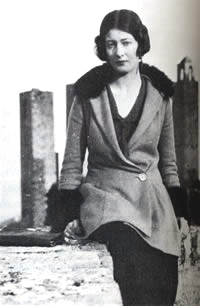Julia Strachey
| Julia Strachey | |
|---|---|

Julia Strachey at San Gimignano, 1922
|
|
| Born | Julia Frances Strachey 20 August 1901 Allahabad, India |
| Died | 1979 United Kingdom |
| Occupation | novelist, photographer, model |
| Notable works | Cheerful Weather for the Wedding, The Man on the Pier, An Integrated Man |
| Spouses | Stephen Tomlin (1927–34), Lawrence Gowing (1945-60) |
Julia Strachey (August 14, 1901 – 1979) was an English writer, born in Allahabad, India, where her father, Oliver Strachey, the elder brother of Lytton Strachey, was a civil servant. Her mother, Ruby, was of Swiss-German origin. For most of Julia's life she lived in England, where she worked as a model at Poiret, as a photographer and as a publisher's reader, before she embarked upon a career in novel-writing. She is perhaps best remembered for her work Cheerful Weather for the Wedding, a book originally published by the Hogarth Press and recently reprinted by Persephone Books.
Julia Strachey spent the first six years of her life in India before travelling to London. After her parents' divorce, she moved in with her aunt Elinor Rendel in Melbury Road, off Kensington High Street. Four years later, Julia was sent to Brackenhurst boarding school; and it was during this time that Oliver Strachey began a new romance with Rendel's close friend Ray Costelloe, the niece of Alys Pearsall Smith, then the wife of the British philosopher Bertrand Russell. Julia in turn developed an intimate friendship with Alys, whom she affectionately referred to as 'Aunty Loo'. Smith's unusual and often wicked sense of humour was to have a lasting effect on Julia's literary style.
In 1932 the eccentric and witty Cheerful Weather for the Wedding was published by the Hogarth Press. Virginia Woolf wrote: 'I think it astonishingly good - complete and sharp and individual.' Both through the connections of her uncle Lytton, and the name she made for herself through her writing, Julia soon became integrated into the Bloomsbury Group, frequenting many of its social events. These unique experiences had a strong influence on her fiction. Until 1964, Julia was also an avid member of Bloomsbury's Memoir Club, where she and its other members discussed and wrote about their shared memories.
...
Wikipedia
